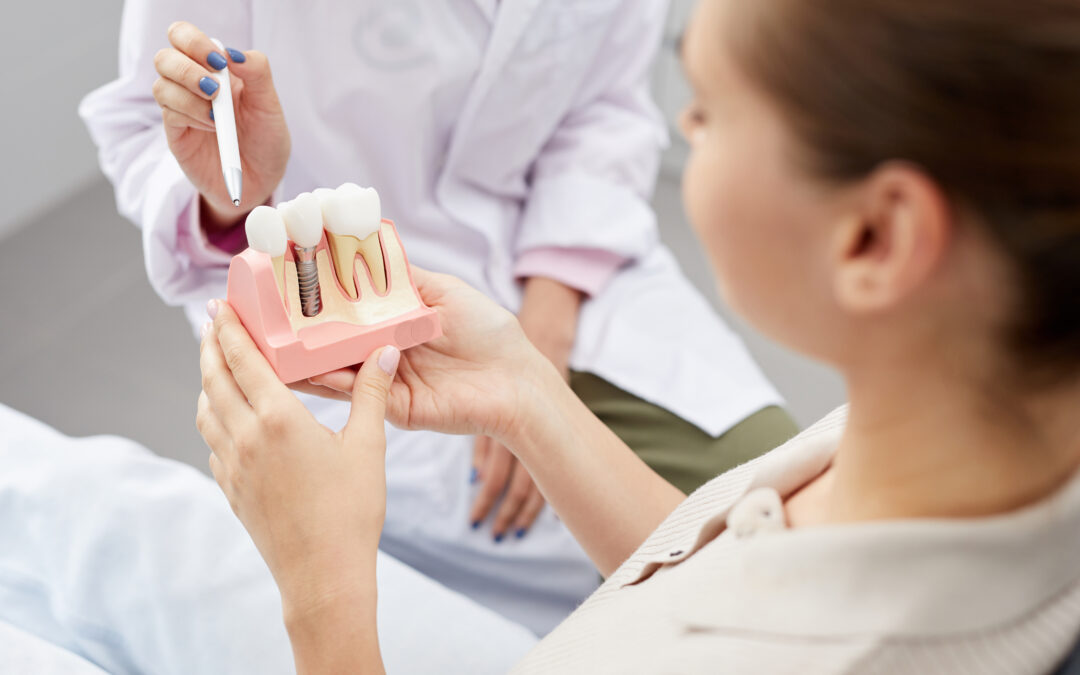Missing teeth can be a blow to your confidence and your ability to chew comfortably. Enter dental implants that offer a long-lasting solution. Acting like artificial tooth roots, they restore function and prevent bone loss in your jaw.
While excited about this option, you’re probably wondering how long the dental implant process takes. Worry not! This guide walks you through the timeline of getting tooth implants, from consultation to enjoying a complete smile again.
What Are Implants?
Dental implants are screw-like artificial tooth roots that are inserted into the jawbone by a dentist. They act as anchors for replacement teeth, like crowns, bridges, or dentures.
Made from materials that are compatible with your body, implants fuse with the jawbone over time. This process, called osseointegration, makes them strong and stable, just like natural teeth.
Dental implants don’t just improve your smile. They’re also a godsend if you want to chew or speak more easily, as well as maintain good oral health. They’re a long-lasting solution for missing teeth and have many advantages over traditional replacements.
How Long Do Implants Take?
How long does the dental implant process take? Well, it depends on a few things. These include your oral health, how many implants you need, and if you need extra procedures.
Usually, obtaining dental implants, starting from the initial consultation to the final restoration, can take several months to complete.
Consultation and Assessment
The consultation with an implant dentist Melbourne or one from your area typically lasts around 30 to 60 minutes. In this session, the dentist will get to the bottom of your oral health. This includes assessing the condition of your teeth, gums, and jawbone. They’ll also discuss your medical history and any concerns you may have. This comprehensive assessment helps the dentist determine if you are a suitable candidate for the procedure.
Treatment Planning
Now, the treatment planning phase begins. This process involves detailed discussions between you and your dentist to develop a personalized treatment plan. This phase may take one to two weeks, tops.
The treatment plan encompasses preparatory procedures like grafting bones or extracting teeth. It also offers a projected timeline for each stage.
Implant Placement
Once the treatment plan is all set up, implant placement procedure is next. The duration? It varies depending on the quantity of implants required and the case’s complexity, among other factors.
On average, one to two hours would be spent per implant. Most patients undergo this step under local anesthesia to minimize discomfort, and you can typically return home the same day.

Healing Period
To say that the healing phase is an essential part of the whole process is an understatement. Why? It’s what facilitates osseointegration. Here, the implant fixture bonds with the adjacent bone. This typically extends over several months. Different cases mean different durations, but it typically falls within three to six months.
Throughout this period, you’ve got to strictly adhere to your dentist’s post-operative guidelines. This would ensure optimal healing and successful implant integration.
Abutment Placement
So osseointegration is already accomplished. What to do next? it’s high time to position the abutment. This step is usually a swift and uncomplicated procedure, often completed during a single appointment lasting approximately 30 to 60 minutes.
An abutment’s role is to act as a connecting element between the implant fixture and the prosthetic tooth. This offers stability and support to the restoration.
Prosthetic Restoration
Following the placement of the abutment, impressions of your teeth will be taken to fabricate your custom prosthetic tooth. The fabrication process typically takes two to three weeks.
Once the prosthetic tooth is ready, it’ll be attached to the abutment during a final appointment, which usually takes about an hour. Your dentist will ensure proper fit and aesthetics, allowing you to enjoy a natural-looking smile.
Follow-Up Care
Even after the prosthetic restoration is complete, regular follow-up appointments with your dentist are essential. These sessions allow your dentist to monitor the health and stability of your implant and address any concerns you may have.
Maintaining proper oral hygiene and adhering to scheduled check-ups are crucial to guarantee the enduring success of your tooth implant. Your dentist will guide you on how often you should visit for follow-up care, typically every six to 12 months.
Are Implants Worth Your Time?
Dental implants are a top-tier option for replacing missing teeth, offering both aesthetic and functional benefits. They mimic the look, feel, and function of natural teeth, allowing you to eat, speak, and smile with confidence. Unlike dentures that can be uncomfortable and require removal, implants are permanently fixed, eliminating worries about slippage or cleaning routines.
Implants also promote better oral health by preventing bone loss in the jaw, a common consequence of missing teeth. This can impact facial structure and even lead to further tooth loss. Implants act like natural tooth roots, stimulating the jawbone and keeping it healthy.
While the implant process itself may take some time, the payoff is significant. Implants are built to last a lifetime with proper care, unlike traditional replacements that often need repairs or replacements. In the long run, implants are a worthwhile investment in both your oral health and overall well-being.
Takeaway
Does embarking on a tooth implant journey sound daunting to you? Well, understanding how the process goes can ease your worries away. Remember that each step, from initial consultation to final restoration, is crucial to the success of this procedure.
The importance of partnering with a trusted implant dentist and following your treatment plan diligently can’t also be stressed enough. In no time, you can restore your smile to its former glory and reclaim that confidence that once slipped off your hands.









